Armenia / Հայաստանի Հանրապետություն – Let’s explore here
What’s it like in Armenia?
Armenia is a transcontinental country – it is located both in Europe and in Asia. Because of this, the information on the country is located both in our European and in our Asian travel destination sections. Don’t worry though, all the information for this amazing country is captured on this page.

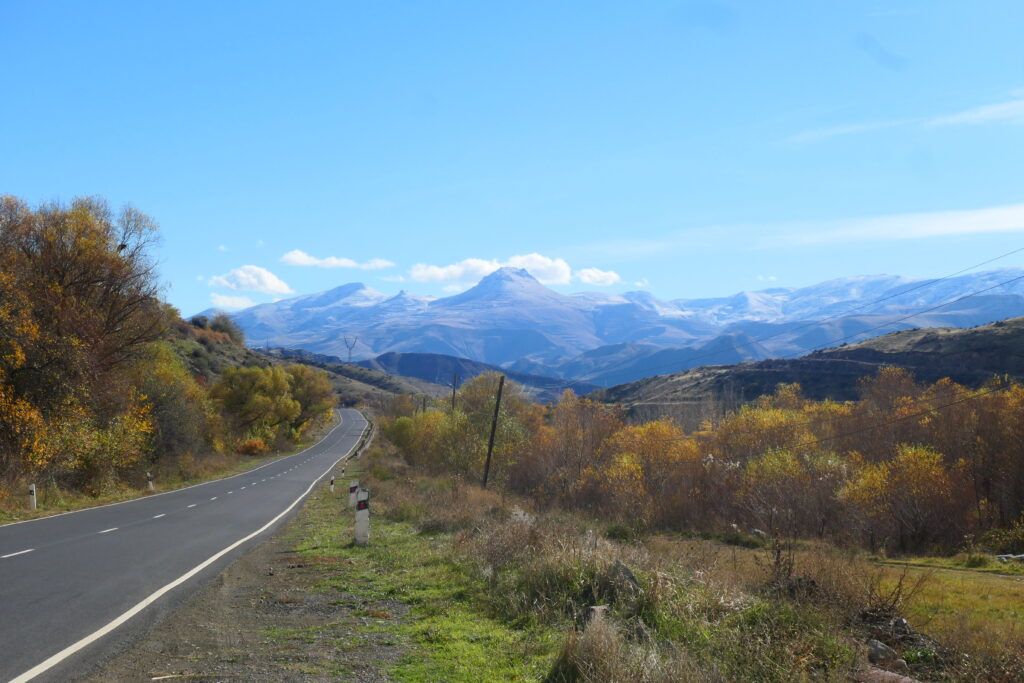
Armenia is a truly stupendous, absolutley stunning, mainly mountainous country that is part of the Caucasus. It really is one of the most strikingly visual places we’ve ever been to. If you like mountains, you’ll find yourself stopping all the time just to take in the views and capture great photos. The highest point is Mount Aragats, not far from the capital, Yerevan, at 13,420ft (4,090m).
Its neighbours include Turkey, Georgia, Azerbaijan and Iran. There are several disputed regions in the country, including Azerbaijan’s exclave of Nakhchivan to the south. When we visited, there were also heightened tensions in the country with Turkey and Azerbaijan. We had to make careful plans for any journeys, as some routes were not accessible due to being blocked by Russian peacekeeping troops.
The population of Armenia is around three million people (2024), almost half of whom live in the metropolitan area of the capital, Yerevan. A far larger number of Armenians live outside of Armenia than within the country, estimates are as high as almost eight million living outside of Armenia, mainly in the USA and Russia.

A bit about the history of Armenia
Armenia has a long and rich history, marked by its ancient civilisation, struggles for independence, and geopolitical challenges.
Ancient History
Armenia’s history dates back to ancient times, with the Kingdom of Urartu emerging in the 9th century BC in the region now known as Armenia. The Kingdom of Urartu eventually gave way to the Kingdom of Armenia, which was established in the 6th century BC. The Armenians were one of the first nations to adopt Christianity as the state religion in 301 AD, making Armenia the first Christian kingdom.
Medieval Period
Throughout the medieval period, Armenia faced invasions from various empires, including the Roman, Byzantine, and Arab empires. In the 11th century, the Seljuk Turks invaded, leading to the fall of the Kingdom of Armenia and the establishment of a smaller Armenian state. In the 16th century, the region came under the control of the Ottoman Empire, while parts of it were controlled by Persia.
Modern Period and Genocide
In the late 19th and early 20th centuries, Armenians in the Ottoman Empire faced increasing discrimination and violence. During World War I, the Ottoman Empire carried out the Armenian Genocide from 1915-1917, resulting in the deaths of an estimated 1½ million Armenians. This event remains a highly sensitive issue in international relations.
Soviet Era
In 1920, Armenia became part of the Soviet Union as the Armenian Soviet Socialist Republic. Under Soviet rule, Armenia experienced industrialisation and modernisation, though it also faced repression and political purges. The region also suffered under Stalin’s policies, including forced deportations and the suppression of Armenian culture.
Independence and Modern Challenges
Armenia declared independence from the Soviet Union on September 21, 1991, following the dissolution of the USSR. The country faced an ongoing conflict with Azerbaijan over the Nagorno-Karabakh region, leading to war in the 1990s and again in 2020. Armenia remains a republic, navigating political and economic challenges, as well as its relationship with neighbouring countries, particularly Azerbaijan and Turkey.

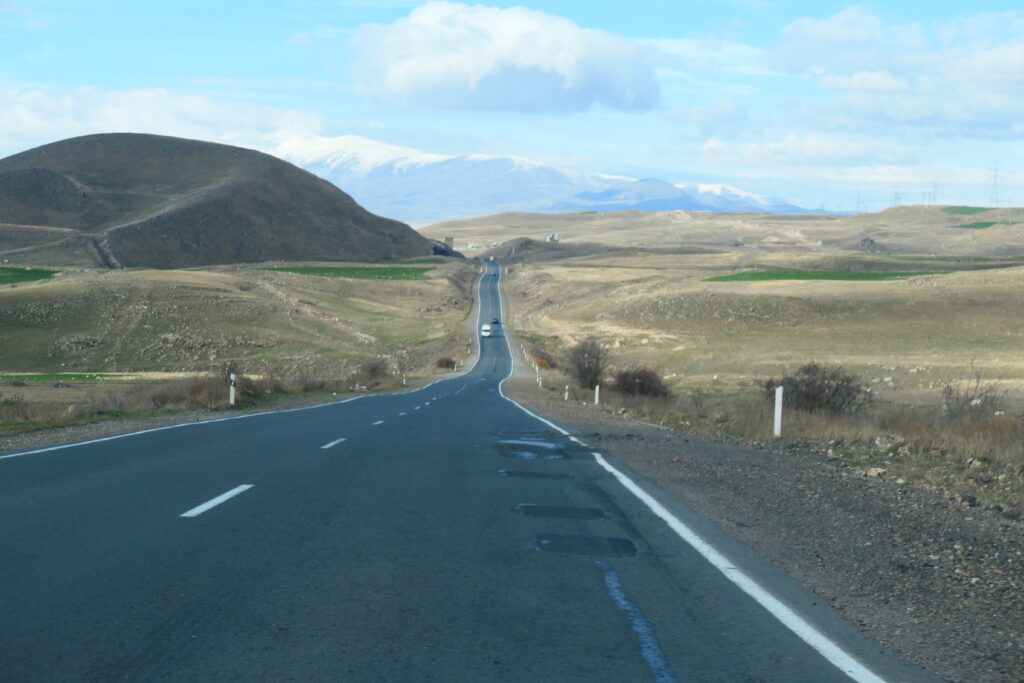
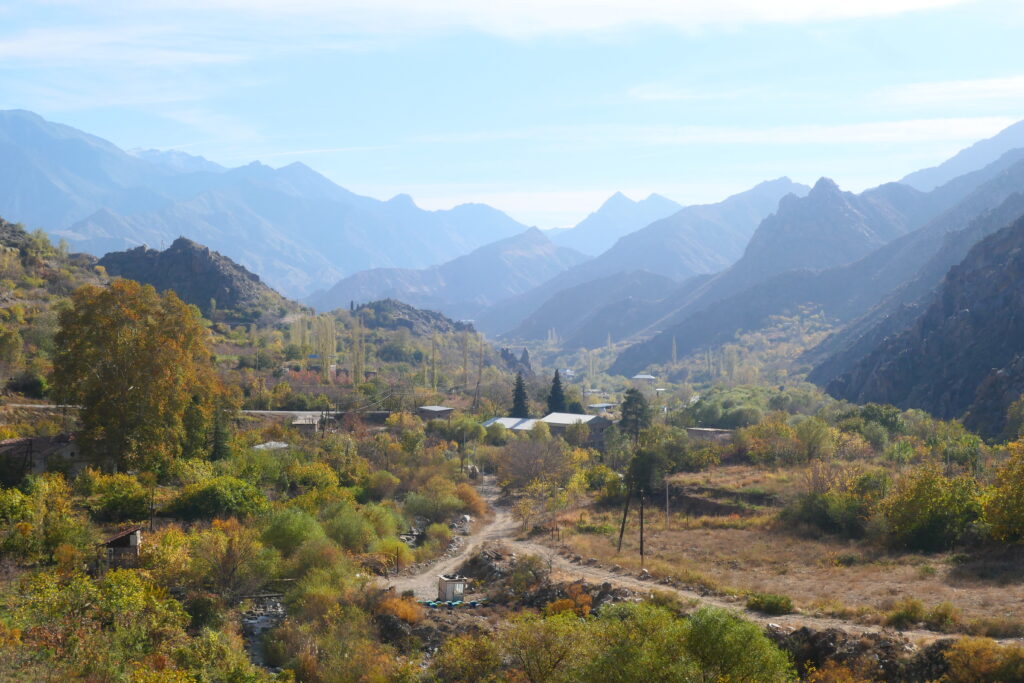


Armenia road trip
Our Armenian road trip was part of a much larger European road trip.
Eastern Armenia
On our road trip through Armenia we travelled from Georgia over the mountains on the main Tbilisi – Yerevan route into Armenia, before heading down to Vanadzor. The journey through Dilijan national park and around Lake Sevan and the Seven peninsula was amazing, as was Hayravank monastery.
Southern Armenia
After driving down to and exploring Yeghegnadzor, we drove southwards over the treacherous roads towards the fantastic Arevik National Park. The route is spectacular and took us via Tatev monastery and Kapan, providing simply amazing views on the way to Meghri on the Iranian border (the southernmost point in Armenia).
The route eastwards was blocked by Russian peacekeeping guards, so we had to double back over the mountains, which were now icy, making our way on to super friendly Goris. From there we travelled up to the brilliant Norovank monastery, and its amazing surroundings.
The capital
Finally we drove up to the brilliant capital, Yerevan. After a few days in Yerevan, we drove north back to Georgia and on to Turkey.
Map of our road trip through Armenia

This is a map of our road trip through Armenia.
Our route took us from Ptghavan – Vanadzor – Dilijan – Hayravank – Sevan peninsua – Lake Sevan – Yeghegnadzor – Tatev – Kapan – Kadjaran – Arevik National Park – Meghri – Goris – Noravank – Yerevan – Bavra
Our favourite places in Armenia
These are some of the best places that we explored on our road trip through Armenia. We’ve put them in alphabetical order.
Arevik national park
Arevik national park is a large mostly mountainous area that sits within Syunik province in the south of Armenia. There are many types of eagles, vultures and falcons that can often be seen in the area. The mountains are simply spectacular and provide absolutely amazing views.
At higher altitudes, the road can become pretty icy and covered in snow. The weather was cold but beautiful and sunny for the most part. These pictures below were taken in late November, early December, and hopefully give you an idea of the conditions.
The roads are also the transit route for Iranian fuel tankers, which crawl at the slowest pace up the mountains – all of them were super polite and pulled over as much as possible, so that we could pass 🙂
There were lots of police on the roads, but none gave us any hassle, unlike in the far north west of the Armenia, and in Georgia.

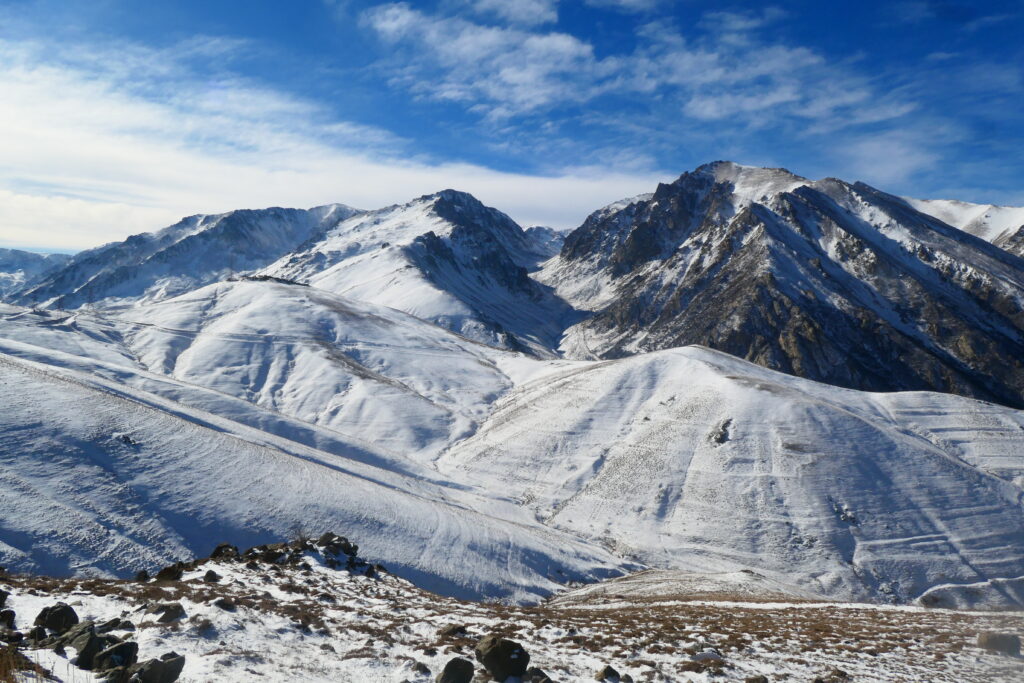

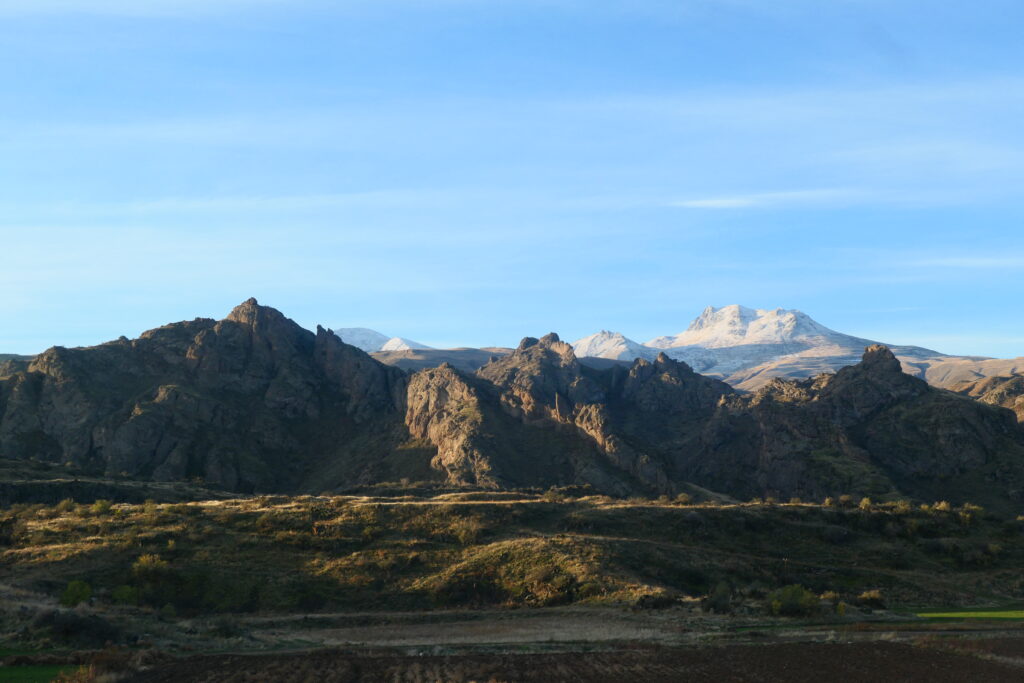
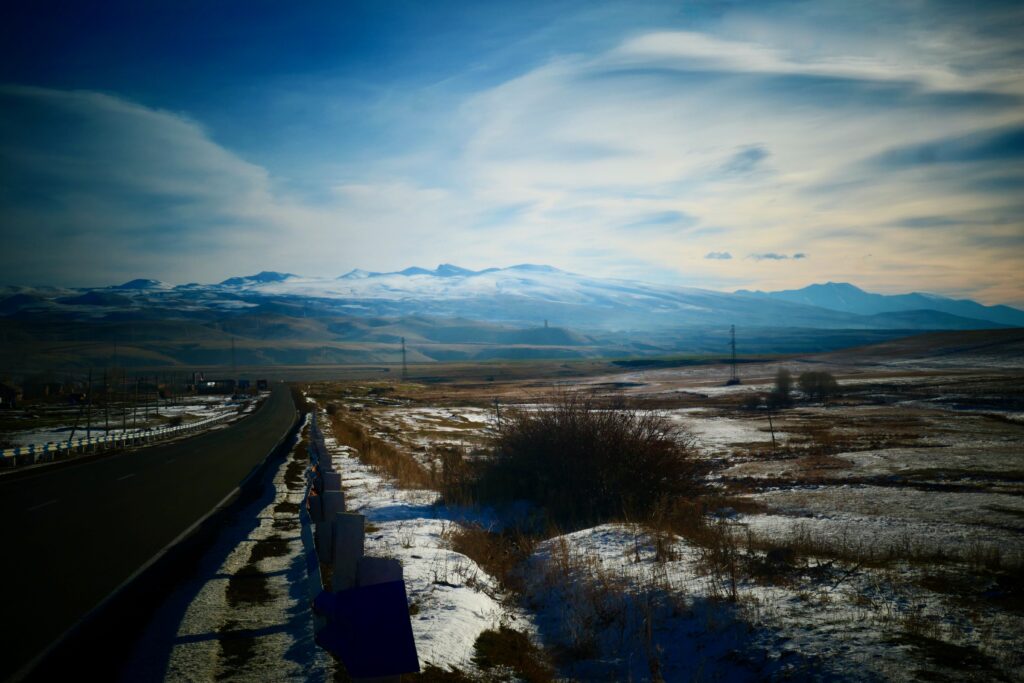



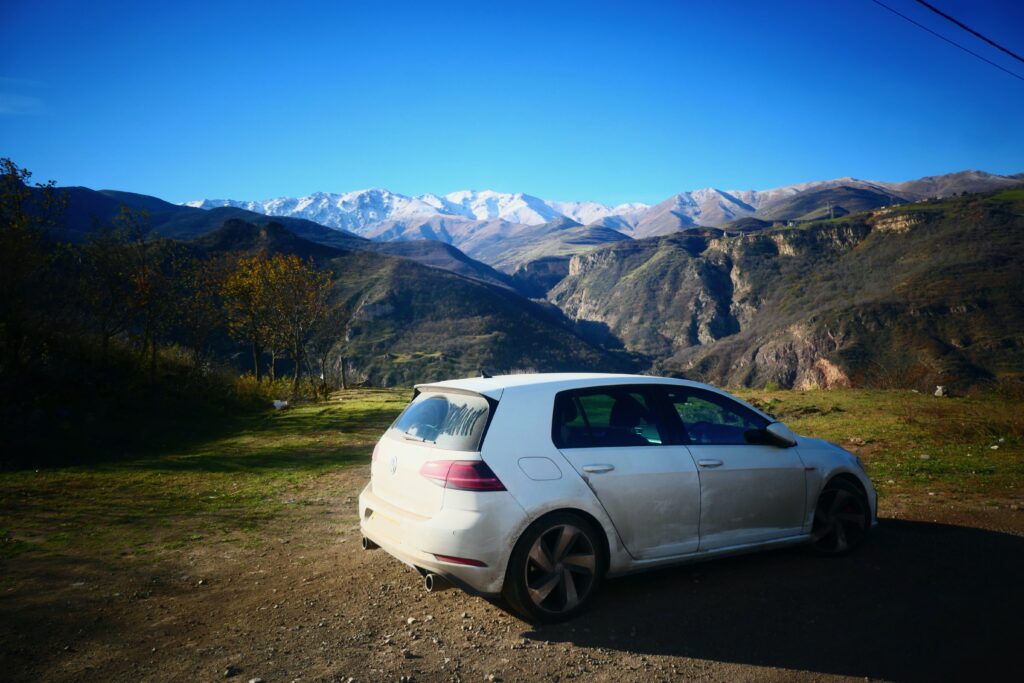

Dilijan national park
Dilijan National Park is truly beautiful – it’s one of four national parks in Armenia, and is renowned for its stunning landscapes and rich biodiversity. Based in the north east of the country, it’s often referred to as the ‘Switzerland of Armenia’, due to the lush forests, tranquil lakes, and scenic mountains.
It covers an area of 93 square miles (240 square km) and is known for its diverse flora and fauna, including several rare species. The park offers numerous hiking trails and is ideal for outdoor enthusiasts. The spa town of Dilijan also lies within the park, blending well preserved cultural heritage with natural beauty.
It was a beautiful day when we were there, but due to the roads becoming higher in altitude, they quickly became pretty icy and covered in snow. These pictures below were taken in late November, early December, and hopefully give you an idea of the conditions.
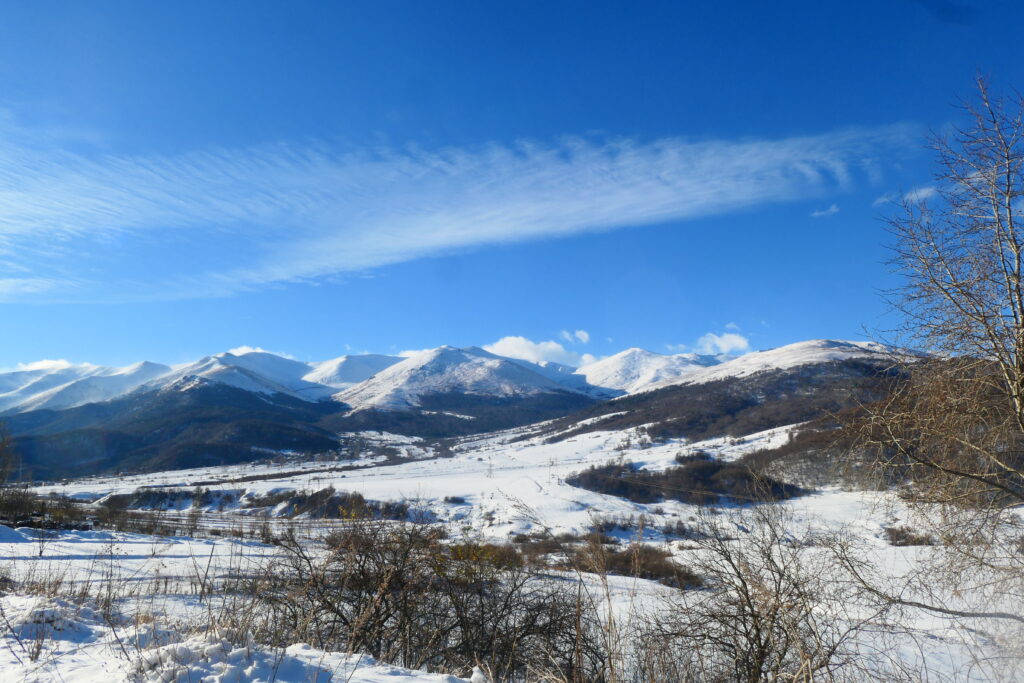

Goris
Goris is a lovely, small town in southern Armenia, located in the Syunik Province, near the Iranian border. It’s surrounded by dramatic cliffs, lush valleys, and scenic hills, and is famous for its unique rock formations and cave dwellings, some of which have been used as homes for centuries. GoItris also boasts historical landmarks, such as the medieval Goris Fortress. It really is a true gem of southern Armenia.
As a cultural centre, it’s a popular tourist hotspot, and thus is well set up with hotels and restaurants. It’s surrounded by incredible scenery and is a great place to make a base to explore the area. We stayed in the excellent Har-Mar hotel, which we highly recommend. The owners were super friendly, and made us a fantastic breakfast. It’s also next to a small supermarket, which was really convenient, and great value.
The roads south of Goris are in an appalling state, with some having collapsed completely and fallen down the mountain sides. Many have potholes several feet deep covering the entire width of the road. Similarly, some of the rods in Goris itself were almost non-existent, having been eroded by the weather. With care though, each could be traversed safely in our VW Golf.
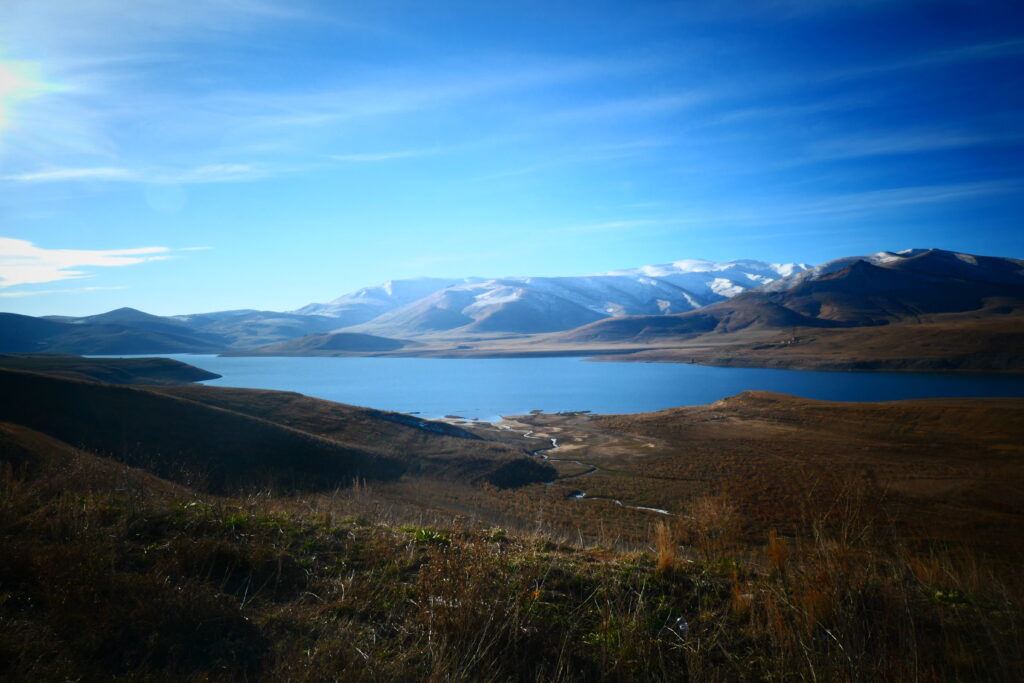




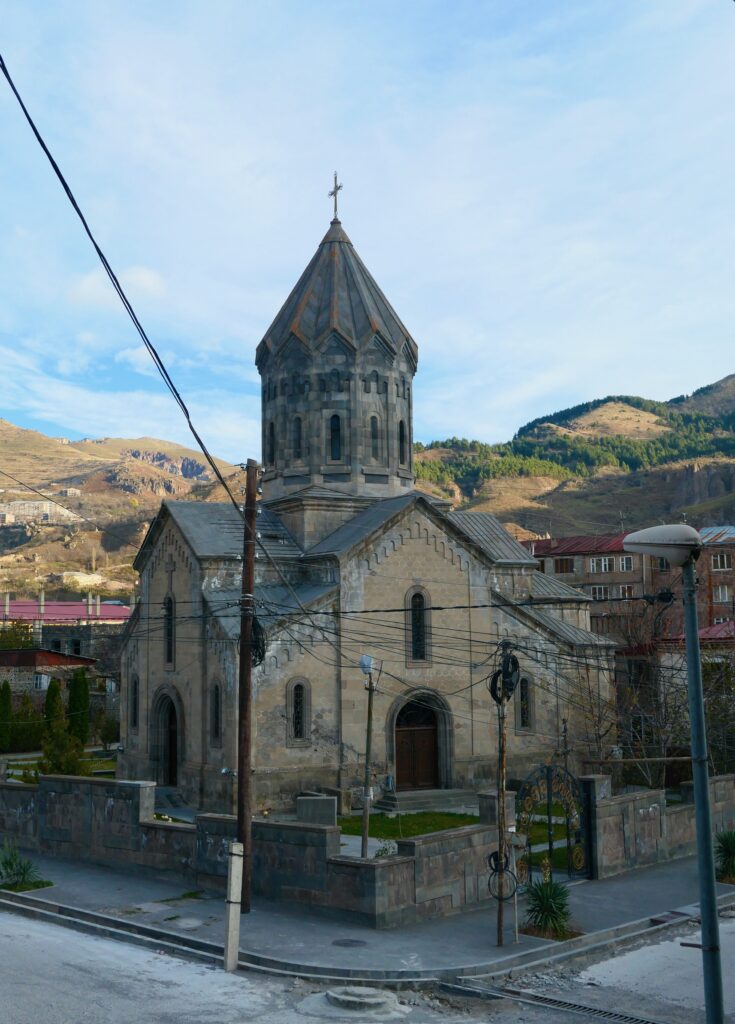


Hayravank monastery
Hayravank Monastery is a serene and historic site located on the shores of Lake Sevan in Armenia. Dating back to the 9th century, this beautiful Armenian Apostolic monastery is known for its striking stone architecture and picturesque setting, offering panoramic views of the lake and surrounding mountains. The monastery complex includes a church dedicated to the Holy Virgin, as well as a bell tower and various khachkars (Armenian stone crosses). Hayravank is a peaceful destination for anyone seeking to explore Armenia’s rich religious heritage, providing both spiritual significance and stunning natural beauty. It remains a testament to Armenia’s historical and cultural legacy.
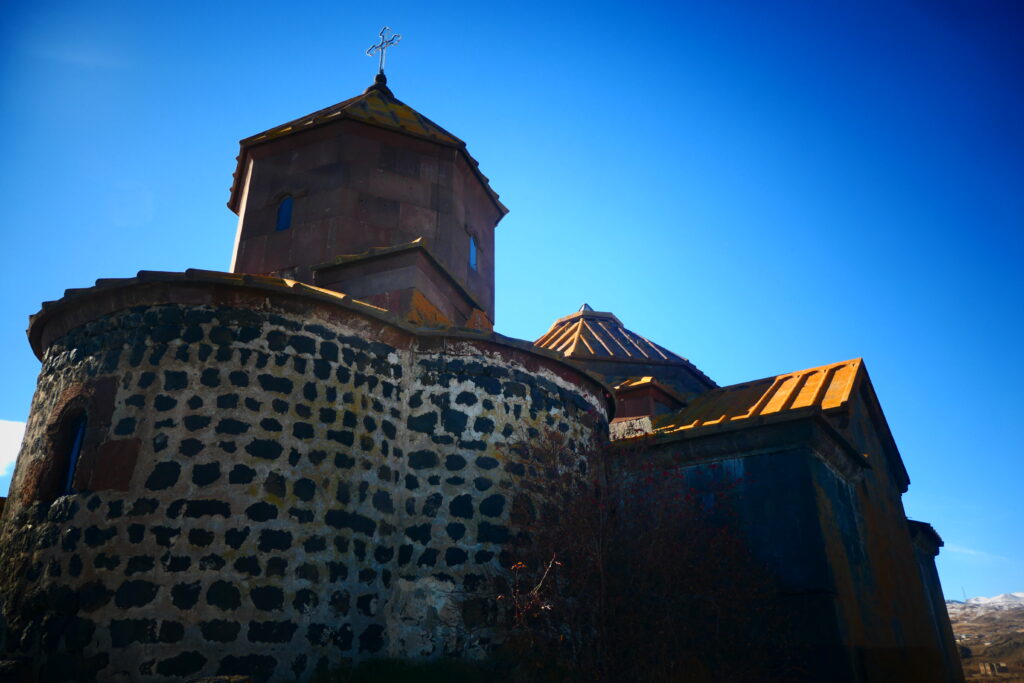
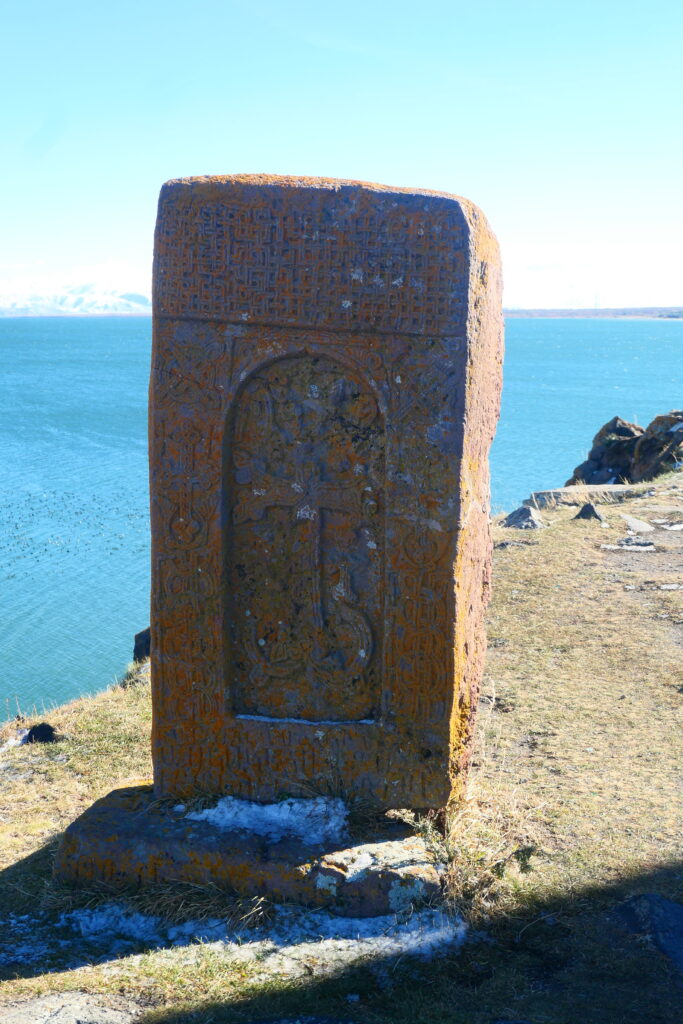
Kapan
Kapan is a sizeable, vibrant town in southern Armenia, near the borders of Azerbaijan and Iran. It’s the largest town in the south of Armenia, having around 40,000 people living there (2023). The name literally means mountain pass, which is apt as it lies between the Bargushat and Meghri ridges of the Zangezur Mountains. From afar, it looks very Soviet-era, but the town itself in bustling with life and is a really interesting place.
Nestled within the picturesque Vorotan River gorge, it’s is known for its natural beauty, surrounded by rugged mountains, forests, and lush valleys. The town has a rich history, with landmarks like the 17th-century Surb Grigor Lusavorich Church and Kapan Fortress, offering a glimpse into Armenia’s past. Kapan is also an important economic hub in the region, with mining and agriculture as key industries. Its proximity to major trade routes makes it a vital town for Armenia’s southern border region.
The views both on the way to, and on the way out of Kapan are also fantastic, and we were really glad that we’d come to visit Kapan.





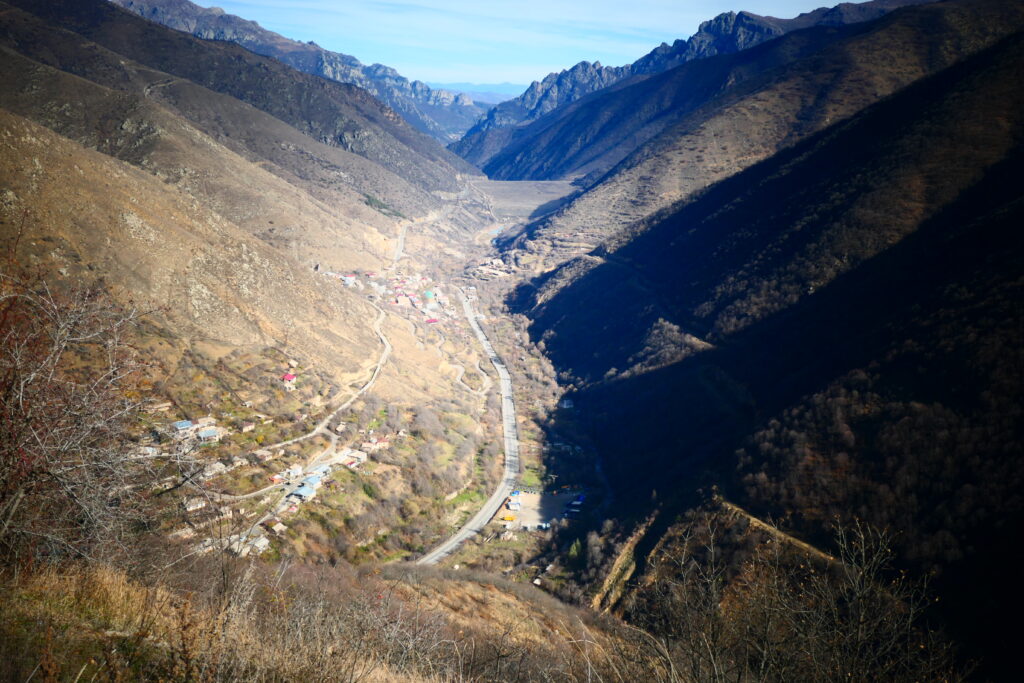
Meghri
Meghri is a very small and very picturesque town on the border with Iran. People are very friendly and the scenery is absolutely spectacular. When we visited, we found that we couldn’t travel east along the border with Iran, as the road was blocked by Russian peacekeeping forces, due to the disputed nature of regional territories and the proposed Zangezur Corridor.
Known for its rich history, Meghri has ancient churches, including the 10th century Saint Stepanos Church, and is a gateway to the historical regions of Nagorno-Karabakh and the Caucasus. The town is also famous for its agriculture, particularly its pomegranates and apricots. It’s strategic location and natural beauty make it a peaceful yet culturally significant destination for anyone exploring Armenia’s southern regions.
The road to Meghri from the Arevik mountains was truly spectacular, and the contrast from driving through snow and ice to the verdant valleys around Meghri were stark. The colours of the terrain came as a shock after all the white in the mountains, making for a really beautiful drive.
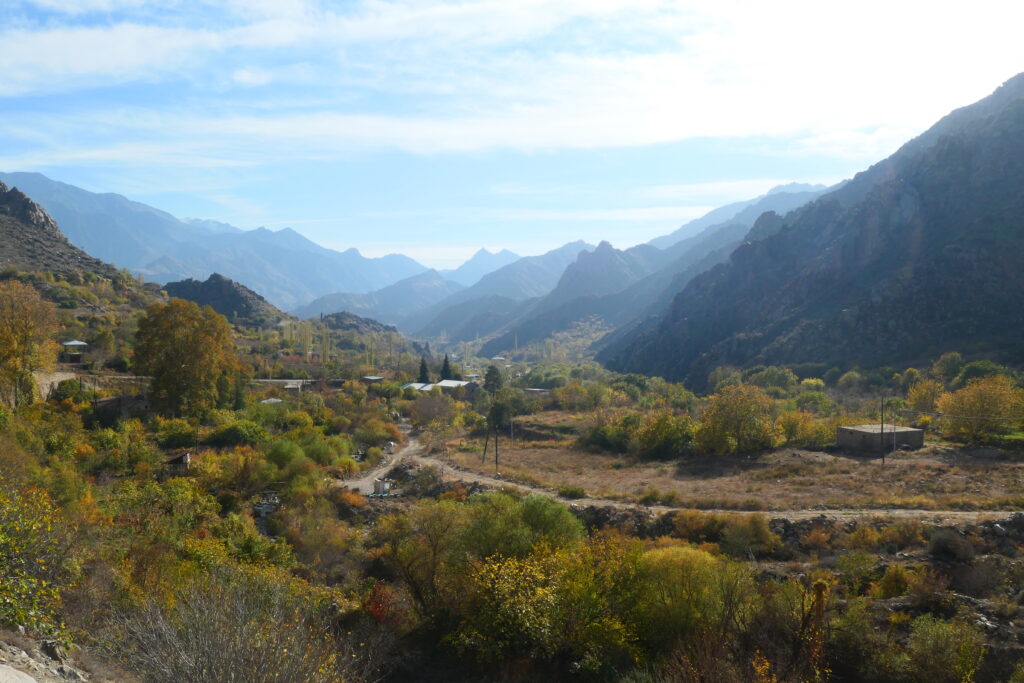
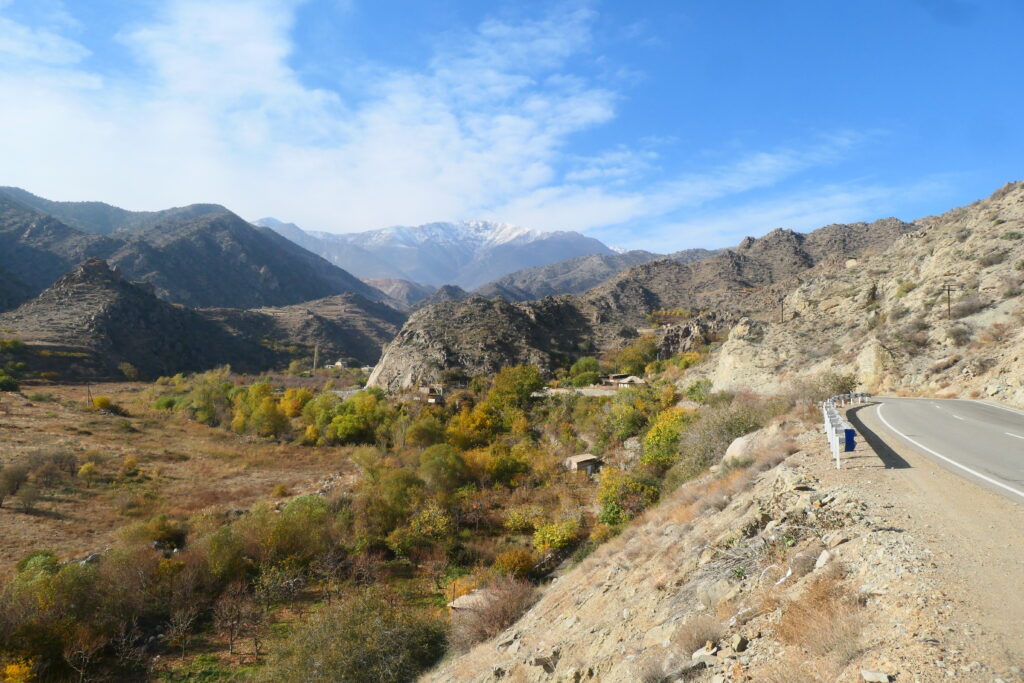
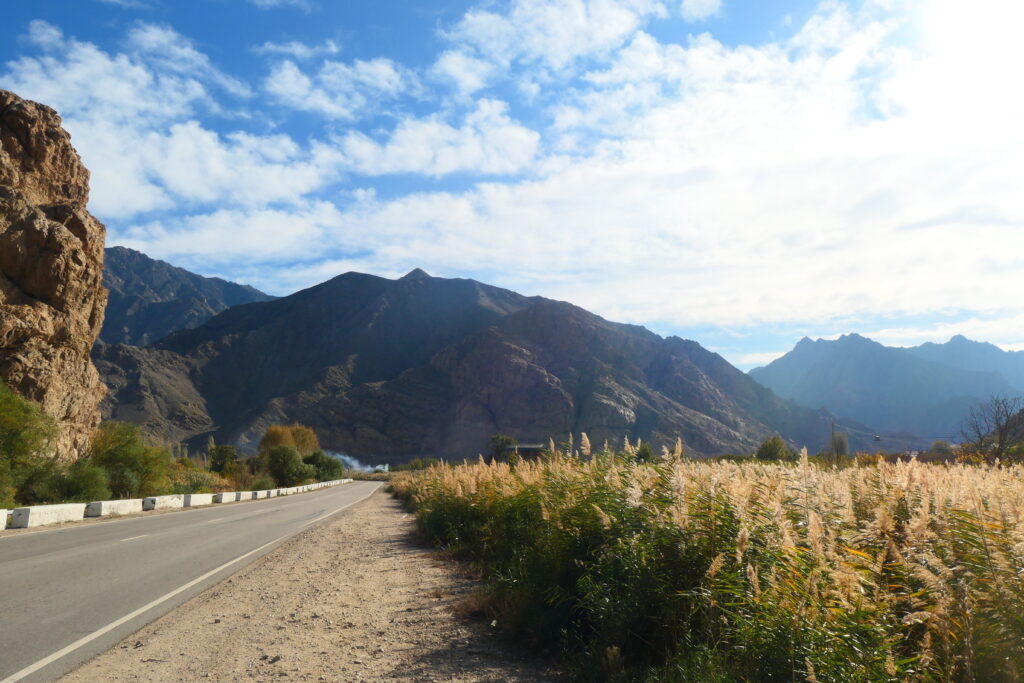


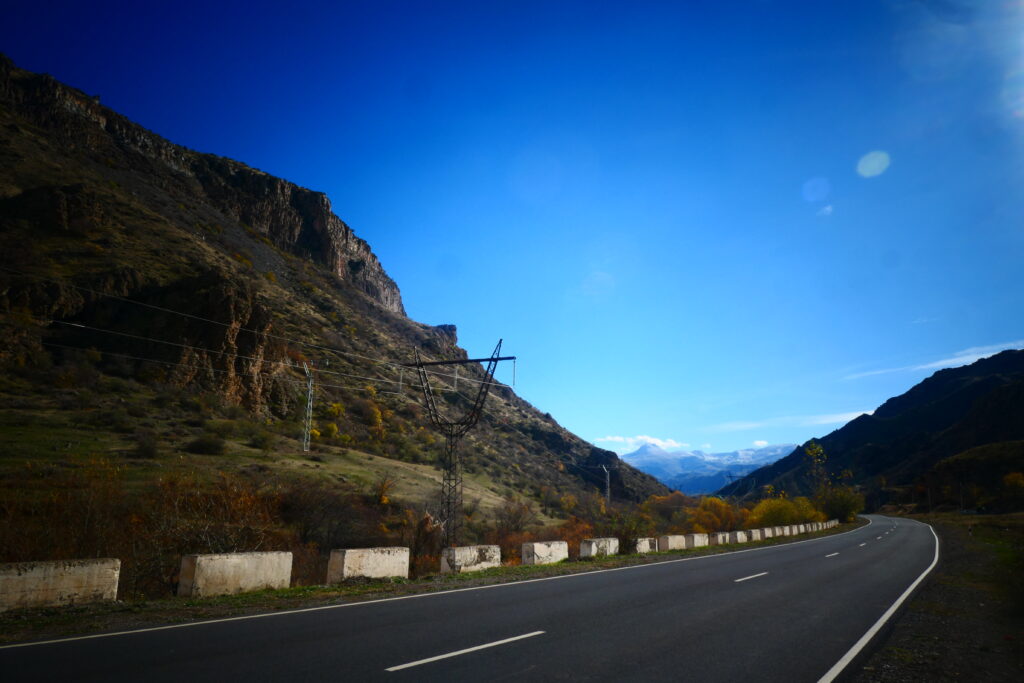
Noravank monastery
Noravank monastery is a simply stunning thirteenth century monastery sitting on a mountainside in the Amaghu valley in west-central Armenia, not far from Yeghegnadzor. The monastery is surrounded by seventeenth century fortress walls, all of which are a beautiful rustic orange-red colour. The rock carvings are simply amazing to see, and have really lasted the test of time.
The monastery includes several important structures, with the most notable being the Surb Astvatsatsin Church, famous for its intricate carvings and impressive two-story façade. Noravank is a significant historical and religious site, offering a glimpse into Armenia’s rich heritage. The picturesque surroundings and architectural beauty make it a must-see destination for those exploring Armenia’s spiritual landmarks.
There are caves in the adjacent valley that in ancient times were used to store wine. Some of the caves date back over 6,000 years and are recognised as the oldest wineries in the world.
Oh, and it’s free to visit the monastery too 🙂



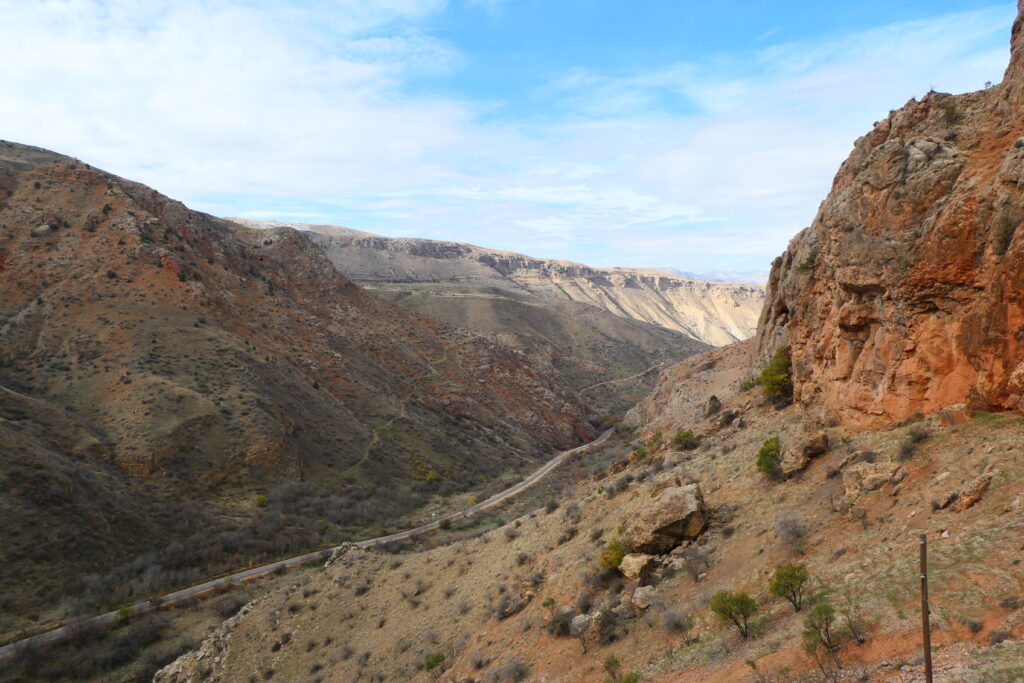


Lake Sevan & Sevan peninsula
Lake Sevan is the largest body of water in Armenia, and one of the largest freshwater lakes in the world, being about 1,900 square miles (5,000 square km) in area – one sixth of the whole of Armenia. The lake sits 6,234 ft (1,900 m) above sea level and is fed by 28 rivers and streams. During Soviet occupation the lake was partially drained, and Seven island became a peninsula.
Known for its crystal-clear waters, Lake Sevan is a popular destination for locals and tourists alike, offering activities such as swimming, boating and fishing. The lake is also significant for its historical and cultural heritage, with ancient monasteries like Hayravank and Sevanavank located on its shores. With its serene atmosphere and breathtaking views, Lake Sevan is a true gem of Armenia’s natural beauty.
It was really tranquil around Lake Sevan when we were there, and the views were brilliant, especially as the weather was cold but really sunny. The mountainous backdrop over the lake was beautiful.







Tatev monastery
Tatev monastery is a stunning ninth century monastery which sits atop a cliff face overlooking the spectacular the Vorotan gorge in the south of Armenia. The monastery complex includes several structures, with the main church, Surb Grigor Lusavorich, being the highlight.
It holds deep cultural and religious significance, once serving as a major centre for learning and religious life. The monastery was responsible for preserving much of Armenian culture and wisdom during turbulent times. Its commanding position on the mountain top makes for a spectacular view.
In the vicinity is the longest reversible aerial tramway in the world, called the Wings of Tatev, which gives you access to the monastery. You can’t miss it if you drive there, as there are multiple adverts along the route and you actually drive beneath it a couple of times.
Oh, and it’s free to visit the monastery too 🙂



Vanadzor
Vanadzor is a small bustling city in the north of the country. Named after its central river, the city is surrounded by the 8,200ft (2,500m) high Bazum and Pambak mountains. The town has a population of around 80,000 people (2024) and is bustling with life on an evening. We found people there to be really friendly and helpful.
As the third-largest city in Armenia, Vanadzor serves as an important cultural and economic center in the region. The city has a rich history, with landmarks such as the Vanadzor History Museum and the nearby Dilijan National Park. Vanadzor is also famous for its wellness centers and mineral springs.
We stayed in the Hotel Kirovkan – an old Soviet era hotel that’s been refurbished inside. The receptionist was really friendly, and although the hotel looks a bit decrepit on the outside, inside it was great. We’d recommend it, although make sure you get a room away from the hotel’s banging heating pipe 😉


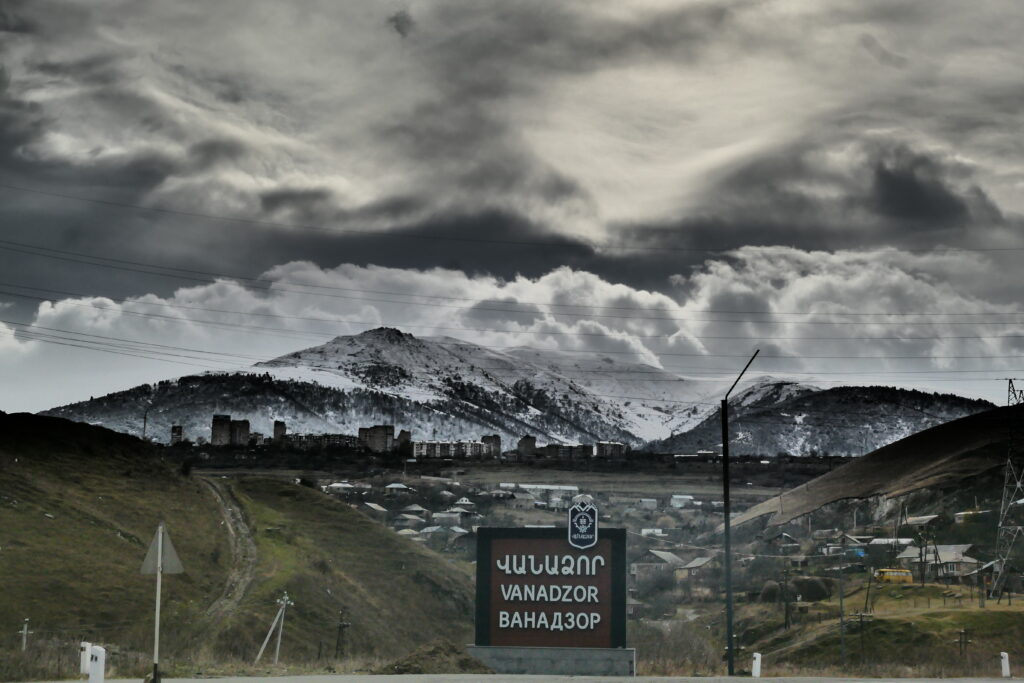


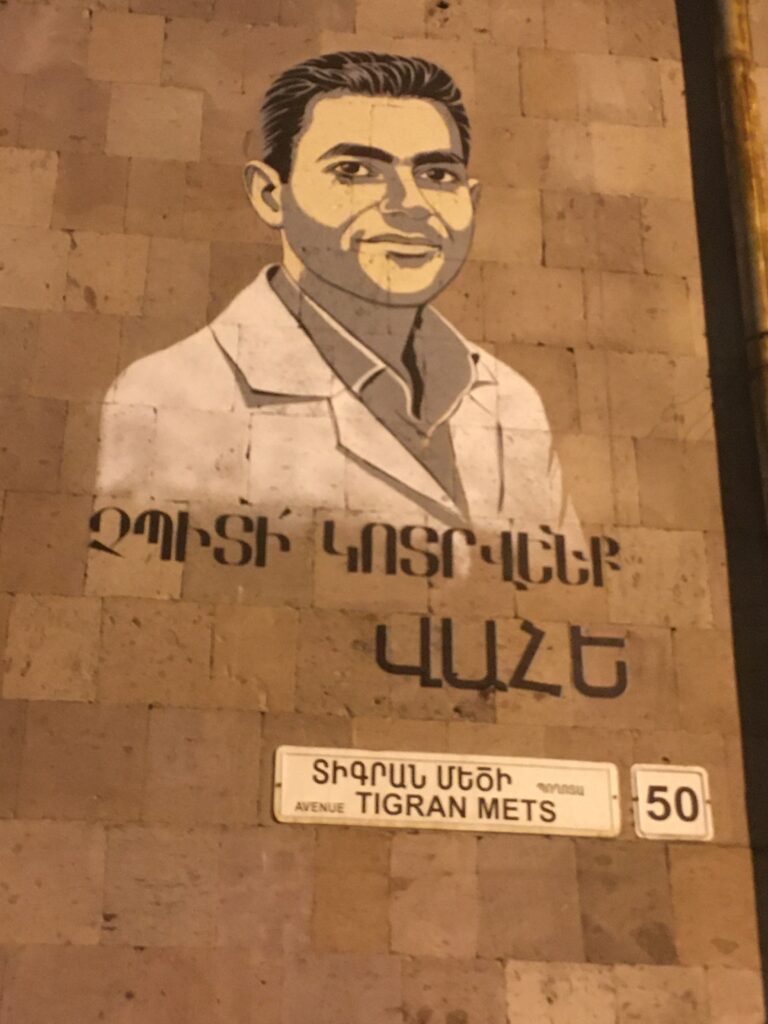


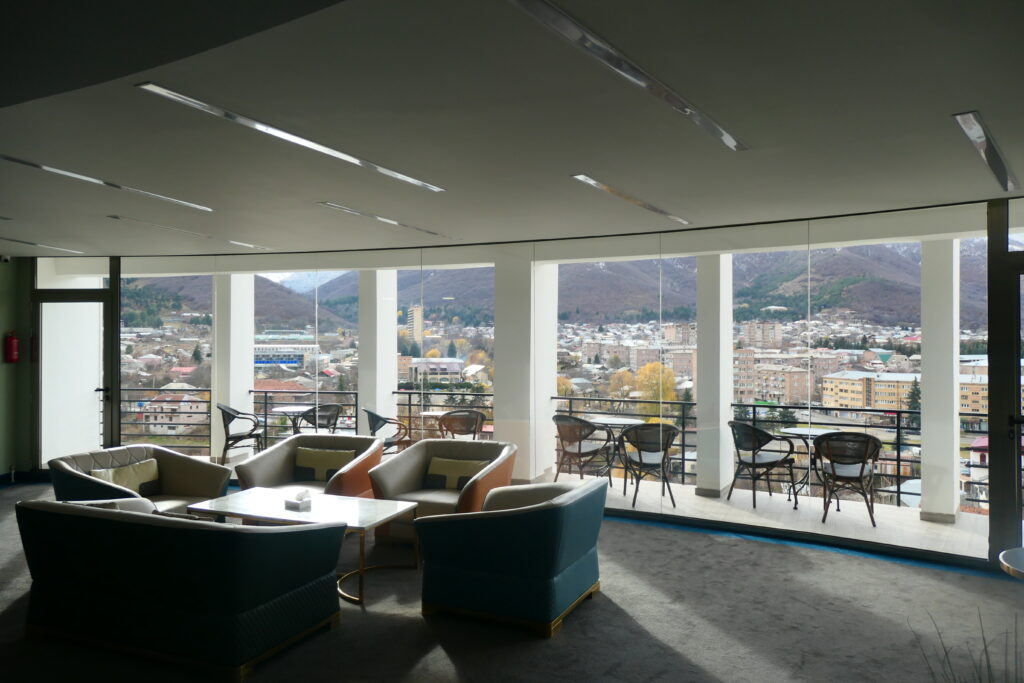
Yeghegnadzor
Yeghegnadzor is a small town in south-central Armenia, surrounded by towering mountains, fertile valleys, and the majestic Arpa River. It sits 3,917 ft (1,194m) above sea level, and has lots of little shops selling all kinds of necessities. Nearby is the ancient cave complex of Areni, famous for its early wine-making history. The town is also a gateway to the Vayots Dzor region, offering visitors access to hiking, cultural exploration, and wine tourism.
People in the main, as is usual in Armenia, were really friendly, making it a great stopover on the way south. However, make sure to AVOID the truly awful Karine B&B, Spandaryan Street 66, 3601 Yeghegnadzor, Armenia – we caught them stealing from us!!
The roads around Yeghegnadzor quickly become mountainous, and are prone to dangerous black ice and snow. These pictures below were taken in late November, early December, and hopefully give you an idea of the conditions.

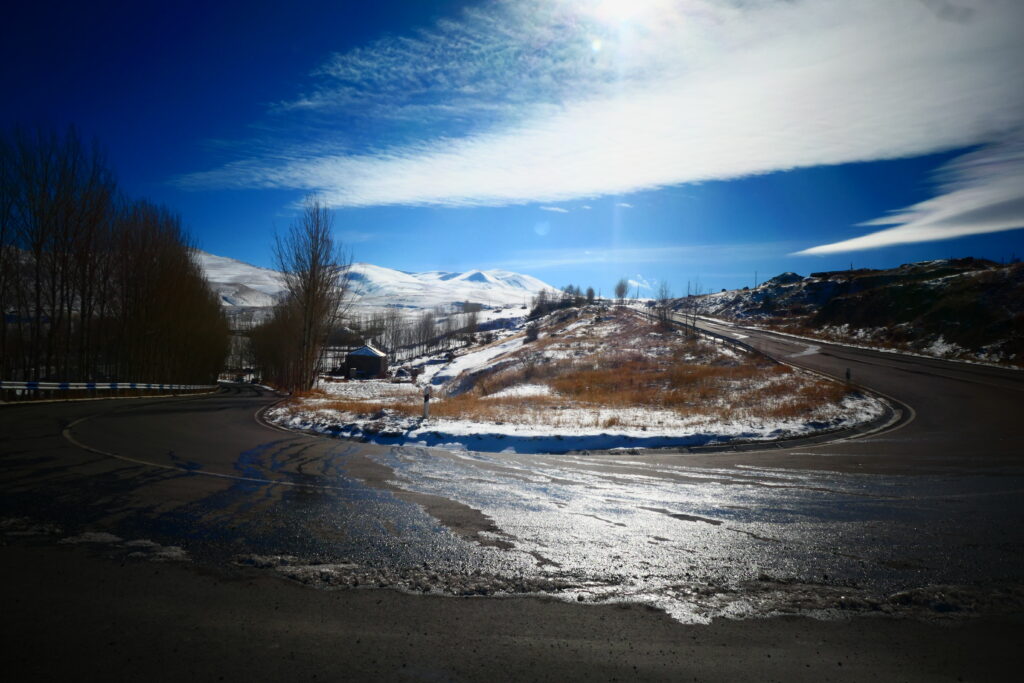
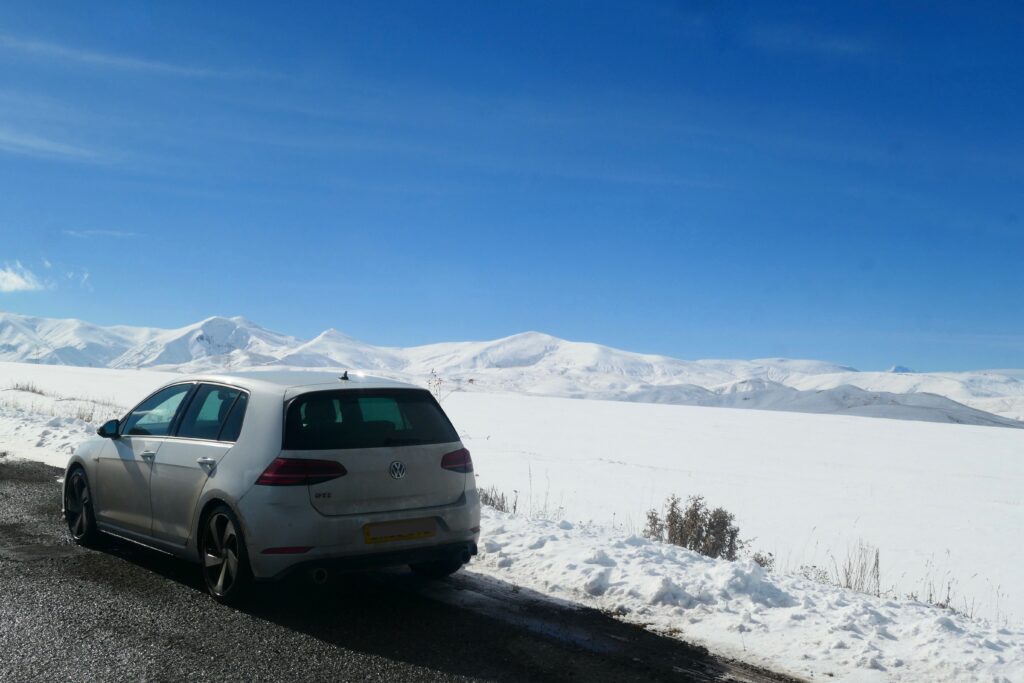

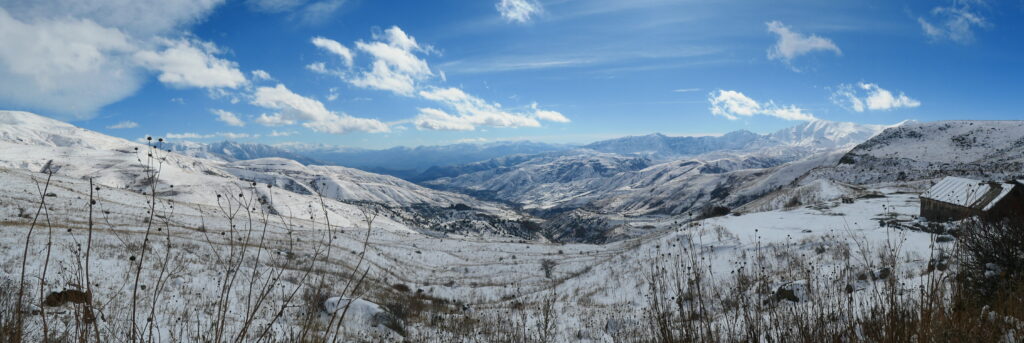
Yerevan
Yerevan is the capital of Armenia and has a population of around one million people (2021). Overlooked by the incredible Mount Ararat, it’s a vibrant and friendly city that contains both ancient and modern aspects. One sight that really must be visited is the Cascade complex which houses a park, a set of multi-tiered steps, an outdoor gallery of art and statues and numerous restaurants and bars. It is truly excellent!
Located near the western border of Armenia, it is the country’s largest city and political, economic, and cultural hub. Founded in 782 BC, Yerevan boasts a blend of ancient landmarks, such as the Erebuni Fortress, alongside contemporary attractions like Republic Square and the National History Museum.
We loved Yerevan, and stayed there for a number of days to take in the fabulous vibe of the city. There’s loads to do and see, with multiple museums and parks, and it felt really safe too. Wandering around taking in the sites and stopping off at excellent cafes and snack bars was great – highly recommended.


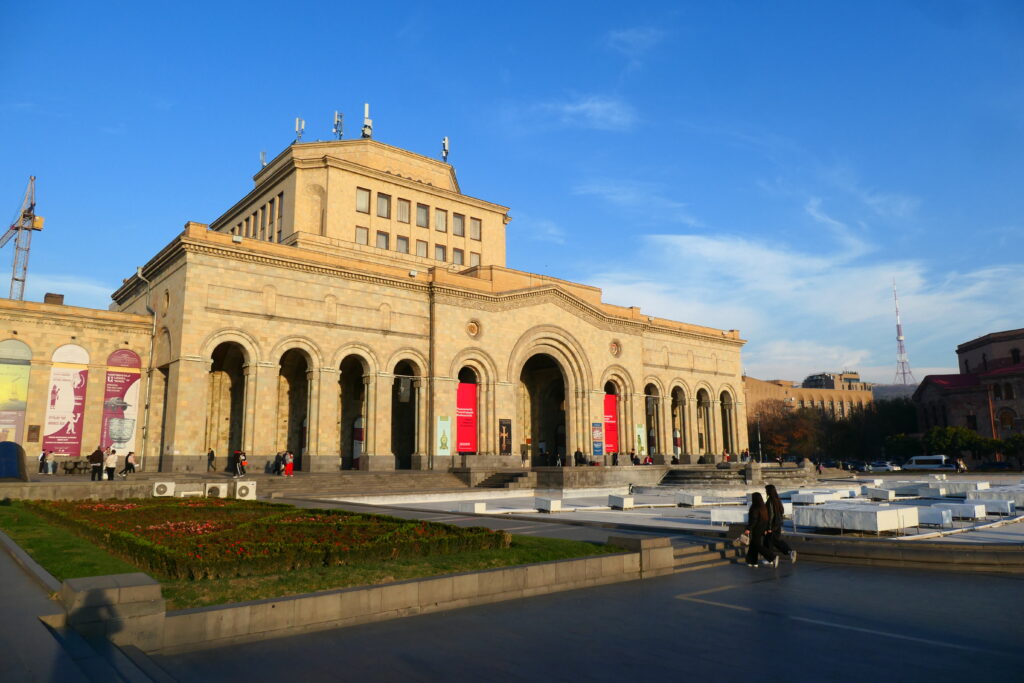

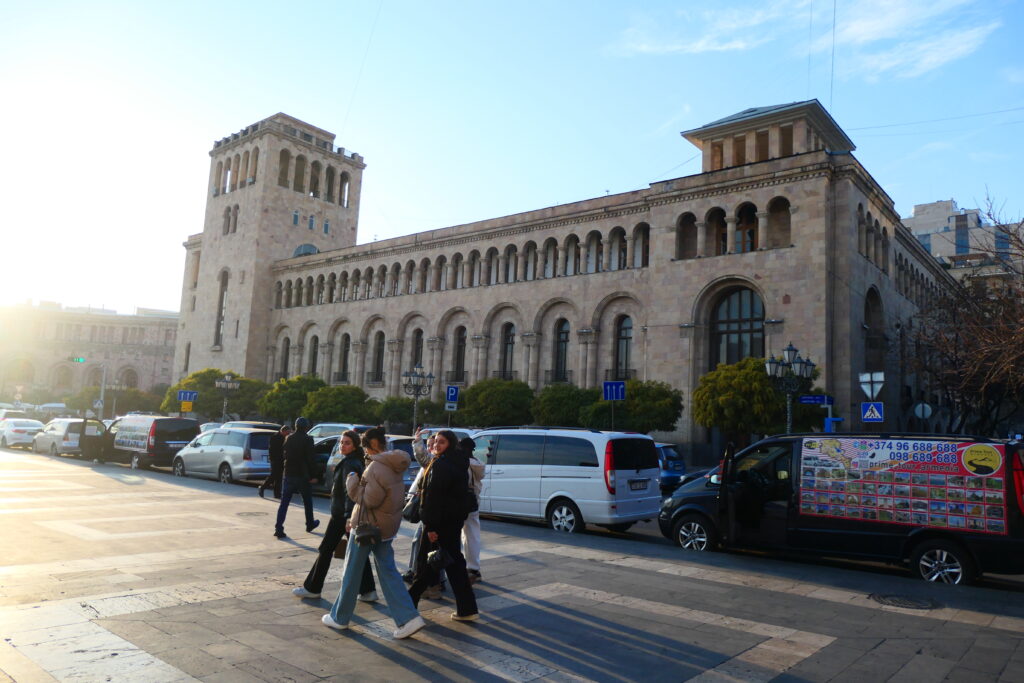
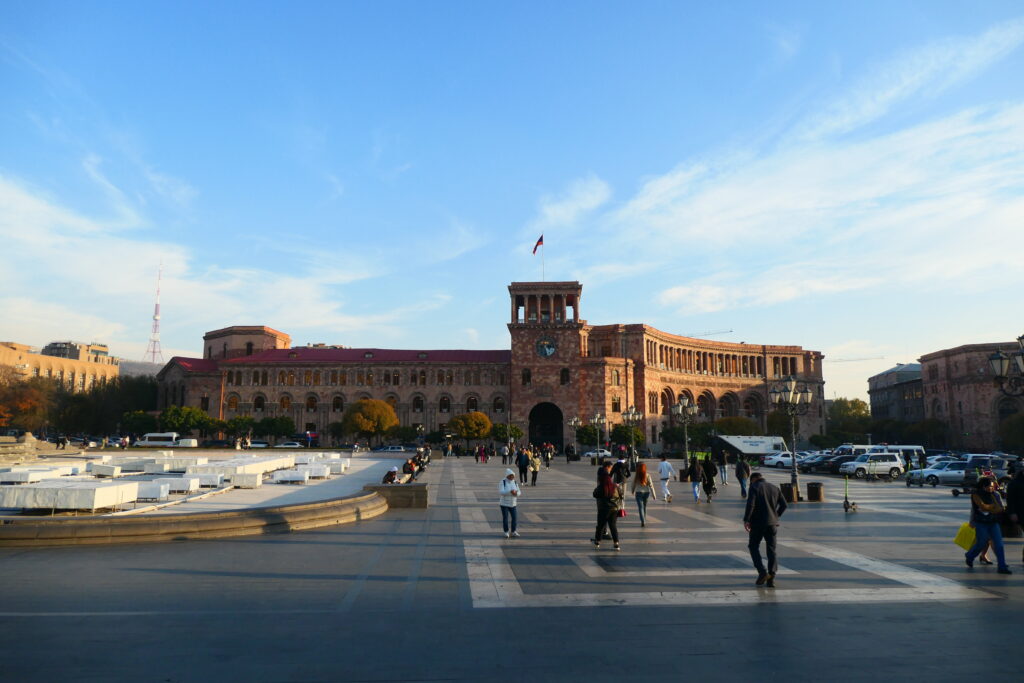


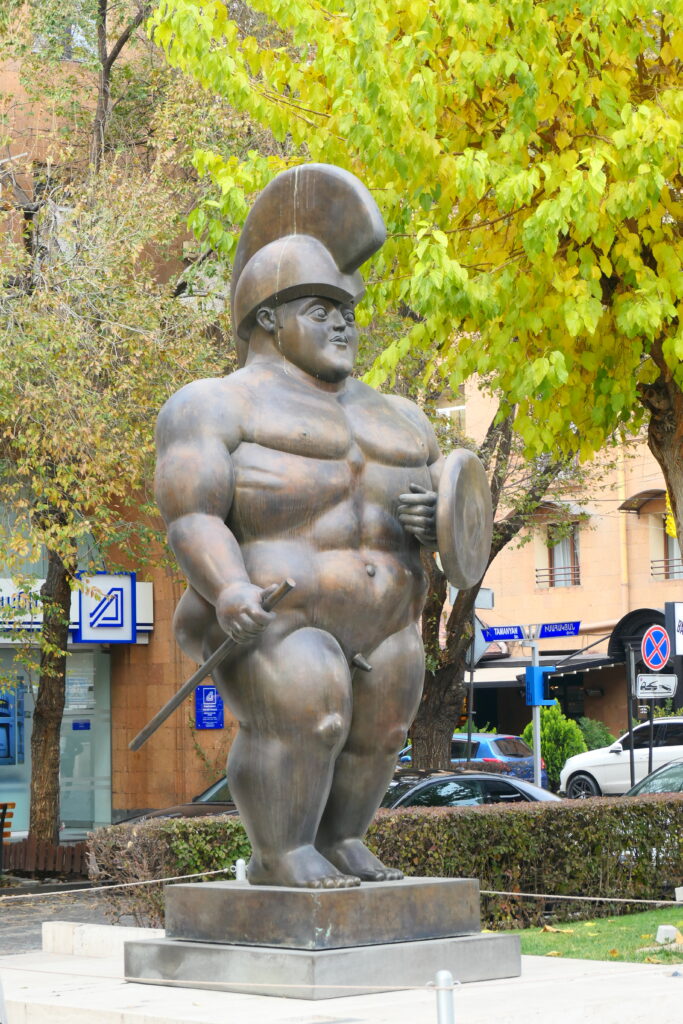




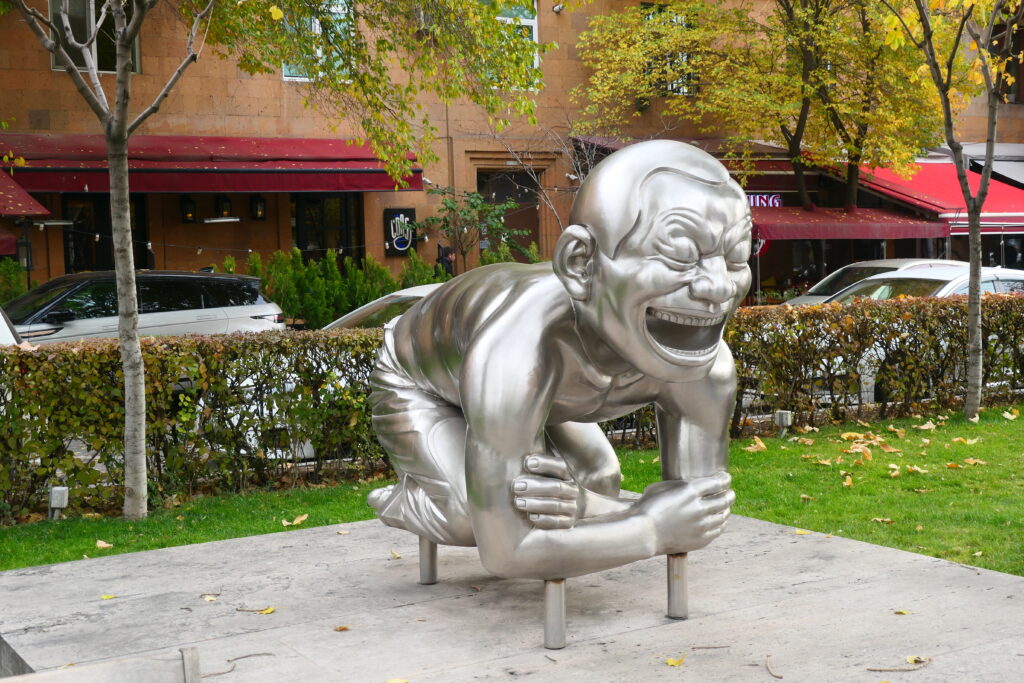
What’s it like to drive in Armenia?
They drive on the right hand side of the road in Armenia.
Driving style
Driving in Armenia is a leisurely affair. Most Armenians outside of the capital are very polite drivers, with very little aggression, and little sounding of car horns. Even in the capital, although it’s super busy and it’s almost impossible to find a parking space, the aggression levels are low compared to many other countries.
Similarly, there are lots of Iranian lorries in the south of Armenia, transporting fuel. All of them were very polite, pulling over as much as possible so that we could pass safely.
Road conditions
Whilst many of the major roads are in good condition, in the villages and towns and more remote areas, and in particular south of Goris, the roads can be in an appalling state, with lots of extremely large potholes or no remaining road at all. Only in Albania did we encounter such poor road conditions anywhere in Europe!
That said, our mighty VW Golf GTI literally took it all in its stride, and so long as we were careful, we found we could navigate the enormous potholes with ease! We never found any roads that required a 4×4 vehicle, rather it is ground clearance that is required.
Police patrols
The police patrol all areas of Armenia regularly, and they’re particularly keen to use their loudspeakers to drum out messages to all and sundry. Not being able to understand the language, we have no idea what they’re saying, but they do talk a lot, and can be heard in every town and city!
In the far north-west of the country we found that the police traffic patrols were particularly keen to stop us – perhaps because we had unusual number plates? We were stopped several times and asked for our driving license. We got the sense that they were more curious than anything else, and we were sent on our way pretty quickly.
Can you drive across the borders in Armenia?
First off, you are not allowed to drive between Turkey and Armenia, all border points are closed due to hostilities between the nations. Similarly all border points are closed between Azerbaijan and Armenia, again due to hostilities between the nations. This means that you can only enter Armenia from either Georgia or Iran.
On entering the country you are required by customs to purchase a car declaration form (for importing your car) at a cost of 10000AMD (£20). Car insurance is readily available from one of many offices at the border town at a cost of 5000AMD (£10). At the Bagratashen – Sadakhlo border crossing, we drove to the roundabout and took the first exit where there is a supermarket and a row of four small offices. We found that the supermarket also offers a good rate of exchange for Armenian Dram.
Do you require an international driving permit in Armenia?
We’ve created a dedicated page to driving abroad, which answers this question, and more, which you might find helpful.
Can you use your UK driving license when driving through Armenia?
We’ve created a dedicated page to driving abroad, which answers this question, and more, which you might find helpful.
Do I need a carnet de passages to drive in Armenia?
We’ve created a dedicated page to driving abroad, which answers this question, and more, which you might find helpful.
What are the speed limits in Armenia?
The speed limits for cars in Armenia are:
- 15 mph (20 km/h) for urban driving
- 35 mph (60 km/h) outside of built up areas
- 55 mph (90 km/h) on dual carriageways
- 70 mph (110 km/h) on motorways
What currency do they use in Armenia?
In Armenia they use the Armenian Dram. Cash is widely used. The use of credit / debit cards is now widespread within the capital, Yerevan. Travellers cheques are accepted at banks in large cities. There are lots of ATMs.
You should make yourself aware of the amount that your bank charges you for using credit and debit cards abroad. Often credit cards are cheaper for purchasing items directly, and for withdrawing cash from ATMs.
What language do they speak in Armenia?
They speak Armenian in Armenia, although many speak Russian and English also, particularly in the capital.
What time zone is Armenia in?
Remember, when you’re planning your next trip to take a look at what time zone it’s in.
Do I need a visa to visit Armenia?
We’ve created a dedicated, more comprehensive page on visas, which you should find helpful. Check it out!
Is wild camping legal in Armenia?
Yes, wild camping is fine in Armenia, although you should avoid national parks and natural reserves.
What plug / socket type do they use in Armenia?
In Armenia they use plug / socket types C and F.


Health issues in Armenia
Is it safe to drink water in Armenia?
Yes, it is safe to drink tap water in Armenia, although in our experience much of it has an unusual taste. Bottled water is readily available across the country. There are also many natural springs throughout the mountains that can also provide water – most of these springs have road signs indicating their locality.
What vaccinations are required for Armenia?
This NHS website is kept up to date with all relevant information on vaccinations in Armenia.
Phones in Albania
What is the country calling code for Armenia?
The country calling code for Albania is +374
What are the emergency phone numbers in Armenia?
- The emergency number for police in Armenia is: 112/ 911 / 102
- In Armenia, the emergency number for ambulance is: 112/ 911 / 103
- The emergency number for fire in Armenia is: 112/ 911 / 101
Armenian SIM card

We bought a Sim card at the Bagratashen – Sadakhlo border crossing, we drove to the roundabout and took the first exit where there is a supermarket and a Viva-MTS store.
We paid AMD4500 (£9) for a 30 day pre-paid card [unlimited data]. The Sim card only worked in Armenia.
If you’ve got some useful info that you’d like to share, let us know!
And don’t forget to check out all the other pictures!
